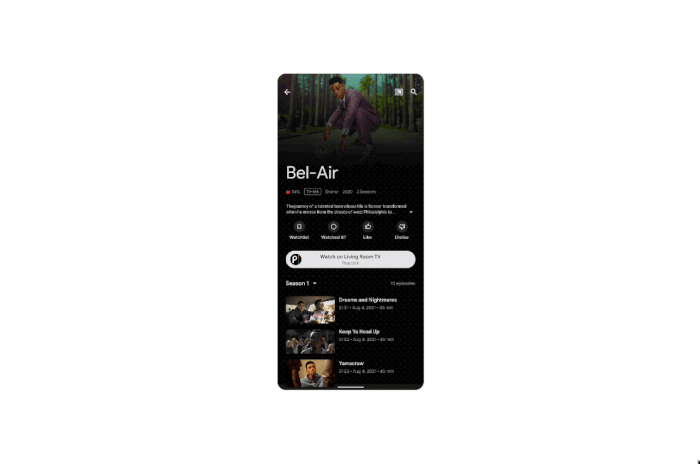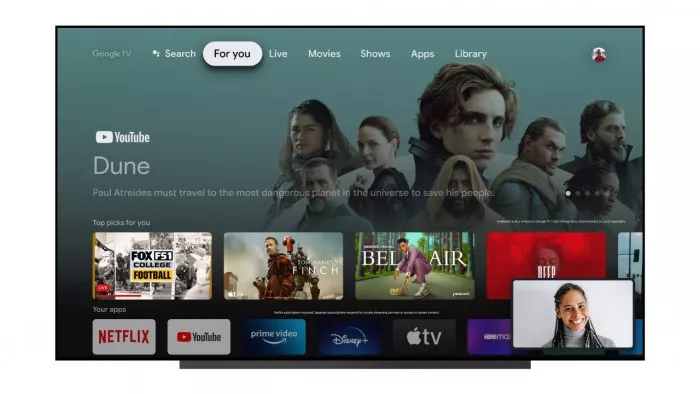Following the transformation of Google TV last year, the app has added movie / TV recommendation, comment / scoring and other functions. At the I / O 2022 Developer Conference on Thursday, the technology giant announced a new plan - later this year, users will be able to send movies and TV programs they want to watch directly from Android devices (smartphones / laptops) to Google TV** In addition, the company shared the growing data related to Android OS and new development tools.

Since the first introduction of the refreshed Google TV interface for chromecast streaming media hardware in 2020, the company has been trying to change the use experience of its online TV and supporting apps.
For example, the "movie and TV" part of Google play is directly moved to the "Google TV" application, and it is pointed out that the latter will provide a one-stop experience of buying, renting, and watching movies and TV programs on mobile devices.
It is worth mentioning that although the company did not share more details about adding projection support to Google TV applications, this feature should be available in the near future. According to a photo disclosed by the official, at least NBC's peacock has determined to provide support in the first round.

As part of the announcement, Google then shared some updates related to the Android TV ecosystem. It can be seen that the number of monthly live devices has reached 110 million (including Google TV), which is higher than the 80 million monthly live data disclosed in the same period last year, and the Android TV platform now provides more than 10000 application resources.
Of course, we can't equate Android TV system with roku or Amazon fire TV and other competitive products. After all, it is not only applicable to Google's first-party devices (such as chromecast streaming hardware), but also provides licenses to partners (including OEM TV manufacturers / pay TV operators).
Google said that at present, 300 + partners are using the platform and cover seven of the top 10 original TV equipment manufacturers. Only 110 million monthly live equipment data can not be compared with the indicators disclosed by roku / Amazon for the time being.

It should be noted that the data of Android TV system is actually calculated by calculating the number of devices actively used in a month - which means that users with multiple devices may be counted repeatedly, and the same home device used by multiple people may be counted only once.
As for roku and Amazon, monthly live data is defined based on "account" - which means that even if the account streams on multiple different devices at the same time, it will only be regarded as the same monthly live user. If you are as opportunistic as Google, the data will be more dazzling.
In December 2020, Amazon disclosed that the monthly active data of fire TV had exceeded 50 million. And up to now, the number is still quoted on the official website. In January this year, it announced that it had sold 150 + million fire TV devices, which means it doesn't have to fear Google's challenge.
Meanwhile, as of 2021, roku has 60.1 million monthly active accounts (rather than active devices). By the first quarter of 2022, the new data has been 61.3 million.
[supplement]
Finally, Google highlighted several developer functions related to Android TV work on Android 13, supplemented by supporting tools focusing on performance and quality, accessibility, and multitasking.
● AudioManager: allows applications to predict audio routing and accurately understand available playback modes.
● mediasession: by integrating with the application, Android TV can respond to the change of HDMI status, so as to save energy and suspend the output of signal content.
● InputDevice API: add support for different keyboard input device layouts (such as QWERTY / AZERTY, etc.), and game developers can also benefit from this.
● global accessibility preference: allow users to enable audio description across applications.
● picture in picture (PIP) API: it supports the picture in picture extension mode on TV to display the video / docking mode from group calls, so as to avoid covering the content on other applications.
● keep clear API: prevent covering and hiding important contents in full screen applications.
Among them, the update of PIP function is the most interesting, because it can introduce more common viewing functions into Android TV ecosystem. Previous competitor Apple Shareplay has been launched to allow a FaceTime "co watching" experience across platforms, including Apple TV.